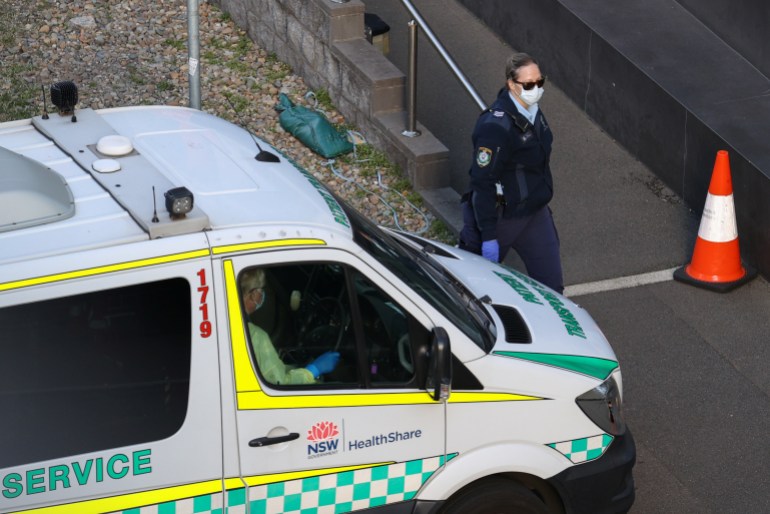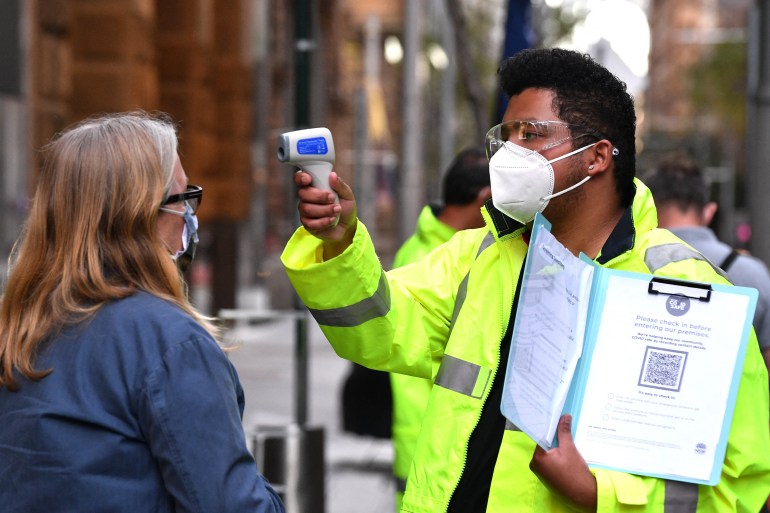Is Australia’s hotel quarantine system broken?
The government says system is ‘99.99-percent effective’ but as Delta triggers new lockdowns there are calls for change.

Melbourne, Australia – Australia is struggling to control an outbreak of the highly contagious Delta variant of the coronavirus that began with an unmasked and unvaccinated driver of an international aircrew in Sydney.
A lockdown in the city, Australia’s biggest, has been extended until the end of August. Other main cities, including Melbourne, are now easing restrictions, but states have imposed curbs on interstate travel.
Keep reading
list of 4 itemsAustralia deports commentator Katie Hopkins over COVID breach
Sydney tightens lockdown as Australia’s COVID-19 cases rise
‘None of us want to be in this situation’: Sydney lockdown stays
The outbreak has put pressure on a government whose vaccination programme is one of the slowest among developed nations and once again raised questions about the hotel quarantine system for international travellers imposed at the start of the pandemic.
While it has helped contain the virus, the requirement that each arrival spends 14 days in strict isolation has not worked out. It has also prevented about 30,000 Australians from returning home and others from visiting family overseas.
Prime Minister Scott Morrison insists that the hotel quarantine programme is “99.99-percent effective.”
But there have been at least 21 separate leaks from various hotels, which have led to the repeated closure of schools and businesses and significant disruption to daily life as cities are forced into lockdown to stamp out the spread of the virus.
Critics say the system has acted as an incubator and spreader, creating more risk in a country where only slightly more than 13 percent of people are fully vaccinated – the second-lowest rate among OECD or Organisation for Economic Co-operation and Development countries.
“Since November there has been a leak in hotel quarantine on average every nine days,” Mike Toole, a professor of international health, told Al Jazeera. “They have led to numerous community outbreaks in five cities and subsequent lockdowns.”

Toole, who works at the Burnet Institute in Melbourne and has had experience as a medical epidemiologist and in public health, says that instead of the hotels containing the virus, they have at times been the cause of transmission.
“Certain states have not paid enough attention to airborne transmission and the virus has spread in hotel corridors,” he said.
“They have not done reviews of the ventilation in hotels and they don’t give staff adequate respiratory masks.”
Along with the buildings – hotel rooms are designed for holidaymakers and business travellers rather than virus containment – he also blames poor quarantine management.
“The current outbreak of more than 2,000 cases in Sydney was caused by the New South Wales government not requiring a driver of flight crew at Sydney airport to wear a mask,” he said.
“Nor was he vaccinated.”
‘Lack of planning’
Management failings were responsible for the outbreak in the state of Victoria in June 2020, which prompted the state premier to announce a “state of disaster” and enact a months-long lockdown that cost an estimated 12 billion Australian dollars ($8.8bn) during which hundreds of people died.
A subsequent inquiry found that between March and June 2020, a total of 21,821 returning travellers were quarantined in Melbourne hotels, with only 236 (1.1 percent) actually testing positive for COVID-19.
But while community cases in May 2020 had fallen to just 57 – from a peak of 541 – breaches in the quarantine programme led to daily increases peaking at 725 cases in early August.
The report found that the breaches were caused by a combination of poor planning, inexperienced private security and mismanagement by the government agency overseeing the programme – the Department of Health and Human Services.

The “lack of a plan for mandatory mass quarantine meant that Victoria’s Hotel Quarantine Program was conceived and implemented ‘from scratch’, to be operational within 36 hours, from concept to operation,” the report said.
“This lack of planning was a most unsatisfactory situation from which to develop such a complex and high-risk program.”
The outbreak also contributed to the spread of the virus in aged care homes, resulting in nearly 700 deaths and scrutiny into the poor infection-control practices in these facilities.
Mike Toole says that hotel quarantine programmes need to be improved to contain the virus and that each state should be using purpose-built facilities for quarantine, like the Howard Springs centre in Darwin, which has not had any leaks.
In Howard Springs, travellers are quarantined in individual chalets which open to the outdoors rather than an enclosed corridor where the risk from an airborne virus is higher. Unlike a city centre hotel, the facility is also more remote, so fewer people are at risk if there is a breach.
Toole estimates that five new facilities – one for each state – would cost about two billion Australian dollars ($1.5bn), which he notes “is much less than the current economic cost of lockdowns of $1 bn ($750 million) per week.”
“But it would take six months to build them so in the meantime hotel quarantine has to be fixed,” he said. “Otherwise we will continue to have leaks and lockdowns until around 80 percent of people are vaccinated.”
In response to the hotel quarantine inquiry, the Victorian Government has developed plans to build a 500-bed “quarantine hub” outside Melbourne’s city centre.
Based on the Howard Springs model, the centre is set to open in 2022, with New South Wales and Queensland also exploring similar options.
Professor of Epidemiology at Melbourne University Tony Blakely says such purpose-built facilities will have a lifespan well beyond COVID-19.
“We will need purpose-built facilities in this pandemic – and the next,” he told Al Jazeera.

Such facilities might also allow more stranded Australians to return. With the latest outbreak, the government halved the quota of international arrivals creating fresh heartbreak for those separated from home for months.
Blakely estimates that five to 10 times the number of people would be able to go through purpose-built facilities with the same risk of leakage as the existing city hotels.
While the announcement of quarantine hubs and renewed vaccination urgency signals a proactive government response, such actions have been hampered by tensions and finger-pointing between state and federal governments, particularly around funding and management responsibilities.
Australia’s limited vaccination supply has also been subject to interstate squabbles, with each state proffering a case as to why they should be prioritised in the vaccination programme. Morrison recently apologised for the slow rollout.
The recent nationwide lockdowns are estimated to cost the Australian economy at least 10 billion Australian dollars ($7.4bn), and while the case numbers in Australia may seem small compared with countries such as India, Indonesia and even the US, the ongoing policy of virus elimination means that lockdowns are likely to be imposed in response to even the tiniest outbreak.
It is a prospect that is testing millions of Australians who are fast losing patience with bickering politicians and a mismanaged COVID-19 response.